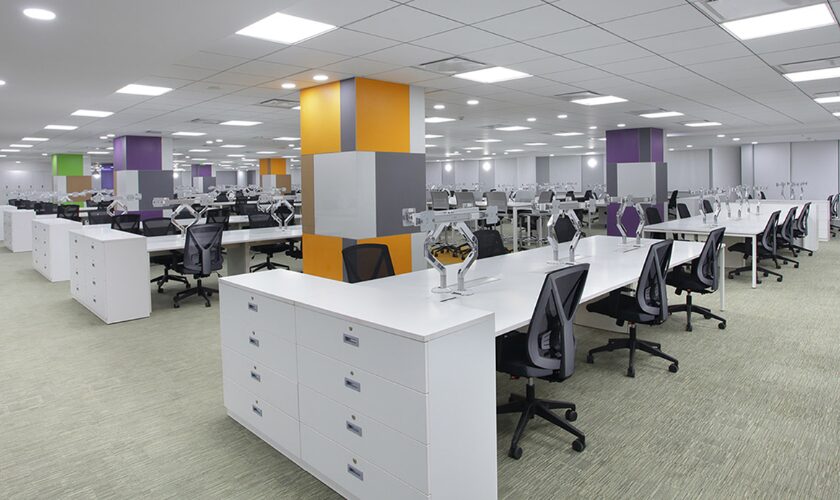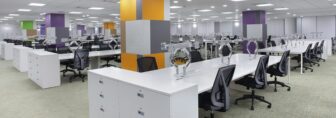Breaking Down Environmental Barriers Of Communication In The Workplace

Environmental barriers in communication refer to external factors or conditions in the physical surroundings that can interfere with the effectiveness of communication. These barriers can disrupt the transmission and reception of messages, leading to misunderstandings or communication breakdowns.
To learn more about these barriers to communication in the workplace, read this post till the end.
Types Of Environmental Barriers Of Communication In The Workplace
Here’s a detailed explanation of the various types of environmental barriers in communication:
1. Noise

Noise is one of the most common environmental barriers to verbal communication – something that we face on a daily basis. However, noise as a barrier to communication can be of many types, such as:
- External Noise: This includes sounds from the surrounding environment, such as traffic, construction work, sirens, or machinery. External noise can make it difficult for individuals to hear and understand each other.
- Internal Noise: Internal noise refers to distractions or mental noise within an individual’s mind. Stress, anxiety, preoccupation with personal issues, or daydreaming can affect one’s ability to focus on communication.
2. Physical Distance
The physical distance between communicators can pose an environmental barrier to communication. In face-to-face communication, being too far apart can make it challenging to hear or see each other’s facial expressions and body language. In remote communication, such as phone or video calls, poor audio or video quality can hinder understanding.
3. Poor Lighting

Inadequate lighting can affect visual communication. Dimly lit rooms or spaces may make it difficult to read facial expressions, gestures, or written materials, impairing the clarity of the message.
4. Temperature And Comfort
Extreme temperatures, whether too hot or too cold, can be distracting and uncomfortable, diverting the focus of communicators away from the message.
5. Physical Barriers

Physical obstructions such as walls, barriers, or partitions can limit visual contact and hinder non-verbal communication cues.
6. Crowded Or Chaotic Environments
Crowded places, busy streets, or chaotic environmental barriers can create distractions and make it challenging to concentrate on any and all forms of communication. This is particularly relevant in public spaces.
7. Technology Issues

Technical problems, such as equipment malfunctions, poor internet connectivity, or software glitches, can disrupt virtual communication and cause delays or interruptions.
8. Cultural And Environmental Differences
Cultural and environmental factors can lead to misunderstandings. For example, different cultural norms regarding personal space or noise tolerance can affect communication effectiveness. In addition, language barriers of communication should also be considered here.
9. Time Zones

When communicating across different time zones, scheduling conflicts and fatigue can be barriers to effective communication. It’s essential to consider time differences and plan accordingly.
10. Location And Accessibility
In some cases, the physical location of individuals may pose challenges. Remote or isolated areas with limited access to communication infrastructure can hinder effective communication.
11. Environmental Pollution

Pollution, such as air pollution or chemical spills, can disrupt communication by affecting the health and well-being of communicators or making it unsafe to gather for face-to-face meetings. Here, I believe the Covid 19 pandemic will be a good example.
12. Natural Disasters
Natural disasters like earthquakes, hurricanes, or floods can severely disrupt communication infrastructure. This makes it challenging to relay information or coordinate emergency responses.
How To Mitigate Environmental Barriers To Communication At Workplaces?
Mitigating environmental barriers to communication in the workplace is essential for promoting effective and efficient communication among employees and teams. Here are strategies to address and minimize these barriers:
1. Provide a Suitable Physical Environment

A suitable working environment should have these basic necessities:
- Noise Control: Implement noise-reduction measures like soundproofing, white noise machines, or designated quiet areas for focused work or meetings.
- Proper Lighting: Ensure that workspaces are well-lit to facilitate clear visual communication and reduce eye strain.
- Comfortable Temperature: Maintain a comfortable temperature in the workplace to enhance employee comfort and concentration.
2. Optimize Office Layout And Design
Try to arrange workspaces to facilitate communication and collaboration. Open floor plans or well-designed meeting spaces can encourage interaction and reduce environmental barriers. Here, you may use ergonomic furniture and seating arrangements to promote comfort and accessibility during meetings and discussions.
3. Technology Management

Regularly maintain and update communication technology and equipment to prevent technical disruptions during meetings or video conferences. Plus, have IT support readily available to address any technical issues promptly to break down environmental barriers.
4. Encourage Clear Communication Practices
Always promote clear and concise communication among employees. Encourage the use of email subject lines, clear agendas for meetings, and effective written communication. In addition, emphasize active listening skills to ensure that employees are attentive and engaged during discussions. Managerial communication will also be beneficial here.
5. Schedule And Time Management

Always be mindful of scheduling to accommodate employees in different time zones or with varying work hours. Use scheduling tools that consider time zone differences. In addition, keep meetings concise and well-organized to avoid wasting employees’ time.
6. Cultural Sensitivity
Foster an inclusive workplace that respects and accommodates cultural differences in communication styles, personal space, and environmental preferences. In addition, employees should also learn about language barriers of communication.
7. Flexibility

Allow employees to choose their work environment when possible. Some individuals may prefer quiet spaces, while others may thrive in more open, collaborative areas. This is a good way to break down environmental barriers to communication easily.
8. Address Physical Disabilities
Ensure that the workplace is accessible to individuals with physical disabilities. Provide ramps, elevators, and assistive technology as needed.
9. Emergency Preparedness

Develop and communicate emergency plans and evacuation procedures clearly. Regularly conduct drills to ensure everyone knows what to do in case of a workplace emergency.
10. Environmental Impact
Be environmentally conscious by implementing policies and practices that minimize negative environmental impacts in the workplace, which can indirectly affect health and well-being.
11. Ergonomics

Provide ergonomic furniture and equipment to reduce physical discomfort, health issues, and environmental barriers to communication. These can hinder communication.
12. Maintenance And Upkeep
Regularly maintain the physical workspace, including lighting, heating, ventilation, and equipment, to prevent issues that can disrupt communication.
13. Training And Awareness

Conduct training sessions and awareness campaigns about the importance of an optimal physical environment for effective communication.
14. Employee Feedback
Encourage employees to provide feedback on the workplace environment and any issues they encounter. Act on this feedback to make necessary improvements in breaking down environmental barriers to communication.
15. Collaboration Tools

Utilize collaboration and communication tools that support remote work and virtual meetings, which can help mitigate the effects of physical distance and environmental barriers.
Frequently Asked Questions (FAQS):
Here are some of the frequently asked questions regarding these barriers of communication.
Ans. Absolutely. If employees have no private places to talk or if they need shared workspaces closeby, it compromises confidentiality. Lack of privacy can discourage employees from frankly airing thoughts or concerns.
Ans. How an office is arranged is very important. Cube-like closed off cubicles prevent spontaneous exchanges, while an open layout can cause noise problems. This requires creating just the right balance to promote both collaboration and concentration
Ans. Moreover, though technology is a help to communication, its abuse or misuse may become an obstacle. Nonstop notifications, technical breakdowns or relying on digital communication over face-to -face interaction may impede effective communications in the working environment.
Ans. Yes, extreme temperatures do affect concentration and discomfort. If the temperature in a workplace is too hot or cold workers may be thinking more about how uncomfortable they are, and thus miss part of what’s being communicated.
Ans. Inadequate lighting tires the eyes and gives off a desolate air. In order to judge non-verbal messages and maintain a pleasant environment that encourages clear expression, adequate lighting is vital.
Ans. Ergonomic factors, for instance a poorly designed seat or desk set-up, also may cause physical discomfort. Discomfort can lead to a distraction, pulling attention away from communication and adversely affecting overall workplace communications.
Ans. Absolutely. A comfortable, well-designed working area increases employee welfare and thus morale and job satisfaction. This environment is conducive to effective communication and will have a positive overall effect on the workplace experience of employees.
Conclusion
By taking proactive measures and maintaining a workplace environment that supports effective communication, organizations can improve productivity, teamwork, and overall job satisfaction among employees. Addressing environmental barriers to communication is an investment in creating a more productive and conducive work environment.
If you have any questions in your mind regarding communication barriers, feel free to comment down below!
More Resources:


























